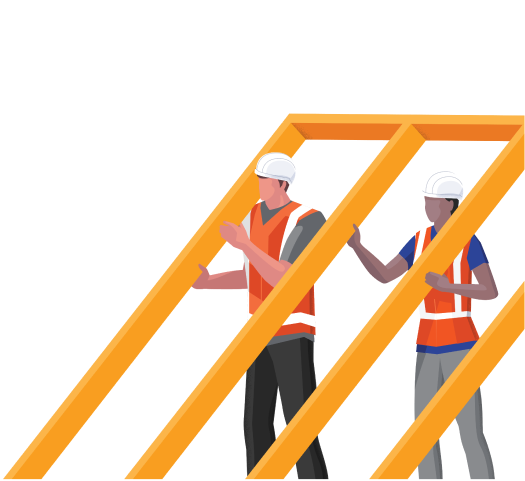— 9 min read
Earned Value Analysis in Construction: Understanding the Intersection of Cost, Schedule and Scope
Last Updated Mar 11, 2024

Earned value management (EVM) is a powerful tool that intertwines cost, schedule, and scope to offer a holistic view of a project's progress and performance. This analysis enables construction firms to accurately assess the extent of work completed (or the value earned) and compare it against the planned value.
In this article, we explore earned value analysis (EVA), its components and how these calculations can be applied to monitor and control project progress.
Contents
Table of contents
Understanding Earned Value Analysis
Earned value analysis is a critical tool in construction project management, serving as a quantitative method to evaluate the real-time performance and progress of a project. By integrating various key components of a project — schedule, scope, and cost — EVA provides a comprehensive picture of where the project stands at any given moment compared to where it was planned to be.
Central to EVA is the understanding that every project is anchored around three primary components:
- Schedule: The timeline for the project's completion.
- Scope: The work and tasks that need to be completed.
- Cost: The budget allocated for the project.
These elements are interdependent; any change in one can significantly impact the others. EVA helps in assessing the status of these components and then balancing them throughout the project’s lifecycle to ensure success.
Earned value analysis allows project managers to answer the following questions:
- Is the project on schedule?
- Is the project on budget?
- How much more money do we need to complete this project?
- What will the overall cost be at completion? And when will the project be completed?
Key Components in Earned Value Analysis
To effectively implement EVA, it is essential to understand its three fundamental components:
- Planned Cost/Planned Value (PC or PV): This represents the estimated cost of the work scheduled to be completed by a certain date. It sets the baseline against which actual progress is measured.
- Earned Value (EV): This represents the value of work actually completed to date. It's often expressed as a percentage of the total project budget and reflects the real progress of the project against the planned schedule and budget.
- Actual Cost (AC): This is the actual cost incurred for the work completed by the specified date. It indicates the financial health of a project.
By assessing the earned value of the work completed, project managers can gain a clear understanding of whether the project is aligning with its financial and time objectives.
Using EVA to Calculate Project Performance
Using planned value, earned value and actual cost, EVA calculates two primary metrics:
- Schedule Variance (SV): Indicates whether the project is ahead or behind its planned schedule.
Schedule Variance (SV) = Earned Value (EV) - Planned Value (PV)
- Cost Variance (CV): Measures whether the project is under or over its budget.
Cost Variance (CV) = Earned Value (EV) - Actual Cost (AC)
These calculations provide project managers with crucial insights into the project’s performance, allowing them to make informed decisions to steer the project back on track if necessary.
Implementing Earned Value Analysis in Construction Projects
Below are the essential steps to effectively implement EVA in construction:
1. Establish a project plan.
Initially, it's crucial to establish a detailed baseline plan that encompasses the project's scope, schedule and budget, as this plan acts as a foundational reference for all EVA-related calculations. It ensures that every aspect of the project is accounted for from the start.
2. Define the Work Breakdown Structure (WBS).
Develop a comprehensive work breakdown structure to segment the project into manageable components. This breakdown is crucial for precise tracking and measuring of project progress.
3. Assign monetary value to WBS.
Each task or section in the WBS is assigned a specific monetary value. This step establishes a cost baseline that is directly linked to the project schedule, allowing for accurate tracking of financial progress alongside physical project milestones.
4. Calculate and chart the planned value.
Utilize the WBS and its assigned monetary values to calculate the PV, which represents the budgeted cost of the work scheduled. Charting the PV over time offers a visual representation of how the budget is allocated across the project timeline.
5. Monitor earned value and actual cost.
Continuously track the actual progress of the project to determine the EV, which reflects the actual value of work completed. Similarly, monitor and record the AC to understand real-time financial expenditures as the project progresses.
6. Evaluate the project’s performance.
Compare the earned value against the actual cost and planned value. This comparison provides insights into the project's performance in terms of schedule adherence and budget management. It allows for early detection of deviations from the plan and facilitates timely decision-making and adjustments.
7. Perform EVA regularly.
Lastly, institute a system for regular monitoring of these metrics at set intervals. This ongoing evaluation ensures that any deviations from the plan are quickly identified and addressed. This step is crucial for maintaining control over the project, allowing for timely adjustments and decision-making based on the latest data.
Make it easier to manage construction.

Challenges with Earned Value Analysis
Despite its numerous benefits in construction project management, earned value analysis also presents a set of unique challenges that require careful consideration and strategic management.
Complexity of Implementation and Maintenance
Implementing earned value analysis demands meticulous attention to detail in the initial stages of the project. To be useful, it necessitates the formulation of an intricate and precise project plan, involving not only defining a comprehensive WBS but also the intricate process of assigning specific costs to each element. This complexity is further amplified in larger or more multi-phased projects, where the sheer volume and diversity of tasks can make the process even more daunting.
Furthermore, the ongoing maintenance of this EVA framework can also be challenging, requiring consistent monitoring and updating the data to ensure its relevance and accuracy throughout the project’s lifecycle.
While EVA offers significant insights and control over project management, the initial establishment and sustained upkeep of this system necessitates significant investments of both time and resources.
Ensuring Data Accuracy and Reliability
The foundation of earned value analysis is precise and up-to-date data. The accuracy and reliability of input data directly influence the effectiveness and credibility of the EVA. Flaws or inaccuracies in data can significantly distort the analysis, leading to faulty assessments of the project's health and progress. This can have far-reaching consequences, often culminating in misguided strategic decisions, misallocation of resources, and ultimately, detrimental impacts on the project's overall success.
It's crucial to establish stringent data validation and verification processes to ensure that the information feeding into the EVA is as accurate, reliable and up-to-date as possible. This involves rigorous data collection procedures, regular audits, and validation checks, especially on complex construction projects where data is extensive and continuously evolving.
Proper Training
It’s key that team members involved in the project are well-versed in the nuances of EVA, from its foundational concepts to the intricacies of its application. However, thorough training demands both time and resources—investments that can be substantial, especially for larger teams or complex projects.
Ensuring a consistent level of understanding across diverse team members, each with their own roles and perspectives, adds additional complexity. While training regarding EVA is demanding, it forms the backbone of effective EVA implementation and, thus, successful project management.
Enhancing EVA with Project Management Software
The integration of earned value analysis with advanced project management software and tools greatly increases efficiency and precision. This integration does more than just streamline the EVA process; it transforms project management with increased effectiveness and accuracy.
Here are some key benefits:
Seamless Data Management and Automatic Analysis
Modern construction project management software and tools are specifically designed to seamlessly manage and analyze large volumes of data, which is essential for accurate EVA. By integrating EVA into these systems, project managers can automate the collection and calculation of crucial data points including Planned Value (PV), Earned Value (EV), and Actual Cost (AC).
Real-time Tracking and Visualization
Another key benefit of this integration is the ability to track project progress in real-time. These tools often come with dashboards and visualization features that provide instant insights into project metrics, making it easier to understand and communicate the project's status. This real-time tracking enables quicker and more accurate responses to potential issues, keeping the project on schedule and within budget.
Enhanced Accuracy and Reduced Administrative Burden
Manual tracking and calculations, which are time-consuming and prone to errors, are decreased substantially when EVA is integrated with project management tools. Automated processes increase accuracy and efficiency, allowing project teams to focus on more strategic aspects of project management rather than administrative tasks.
Collaborative and Centralized Platform
Modern project management software offers a collaborative platform where all stakeholders can access and update information from anywhere. This centralization ensures that all project stakeholders are working with the most up-to-date data, enhancing coordination and decision-making. It also serves as a single source of truth for project performance metrics, reducing misunderstandings and conflicts.
Customization and Scalability
The customization options of these software platforms allow the EVA process to be tailored to the specific needs of the project or the firm. Furthermore, these tools are scalable, accommodating the growth and changes in project or firm size and complexity.
Integration with Other Project Management Functions
Modern project management tools encompass a range of functions beyond EVA, including crucial aspects like resource allocation, risk management, and quality control. By integrating EVA with these diverse functions, a more complete perspective of the project emerges. This holistic approach ensures that any change in one facet of the project is automatically reflected across all other areas, enabling more cohesive and effective management.
Earned value analysis can improve construction outcomes.
Earned value analysis is not just a tool, but a transformative approach to construction project management, offering in-depth insights and control over complex projects.
EVA's integration of cost, schedule, and scope elements is essential for successfully navigating the multifaceted challenges of construction projects. While there are hurdles in implementing EVA, its ability to provide clear, actionable data makes it invaluable for effective project management. Ultimately, EVA stands out as a key driver for efficiency, accuracy, and strategic decision-making in the construction industry, ensuring projects are delivered on time and within budget.
Categories:
Tags:
Written by
TJ Forbes
12 articles
TJ Forbes is a Senior Solutions Engineer at Procore, specializing in financials products, analytics, ERP integrations, workflows, reporting and accounting solutions. He previously worked as a financial manager and project accountant for Stiles, a commercial real estate firm in Ft. Lauderdale. TJ holds a Masters in Financial Management from Southern Adventist University.
View profileTaylor Riso
38 articles
Taylor Riso is a marketing professional with more than 10 years of experience in the construction industry. Skilled in content development and marketing strategies, she leverages her diverse experience to help professionals in the built environment. She currently resides in Portland, Oregon.
View profileWin More Work
Get discovered for relevant work on the Procore Construction Network.

Explore more helpful resources

Lines of Credit in Construction: The Pros & Cons for Contractors
In the construction industry, contractors often spend large sums of money on materials and other project expenses before they actually get paid for their work. This situation creates a significant...

Trade Credit: The Benefits & Risks to Contractors and Suppliers
Contractors often need to find alternative ways to purchase materials for a project upfront, and one of the most common types of supplier financing options is trade credit. Trade credit...

The Carrying Cost of Slow Payment in Construction
When payments on a construction project are delayed, it’s not just inconvenient — late payments can get expensive. Each day that a contractor has to wait to collect, they lose...

Contractor Financing: The Complete Guide
The financial success of a construction business depends largely on its ability to manage cash flow. Throughout a project, contractors face a significant outlay of cash for materials and other...
